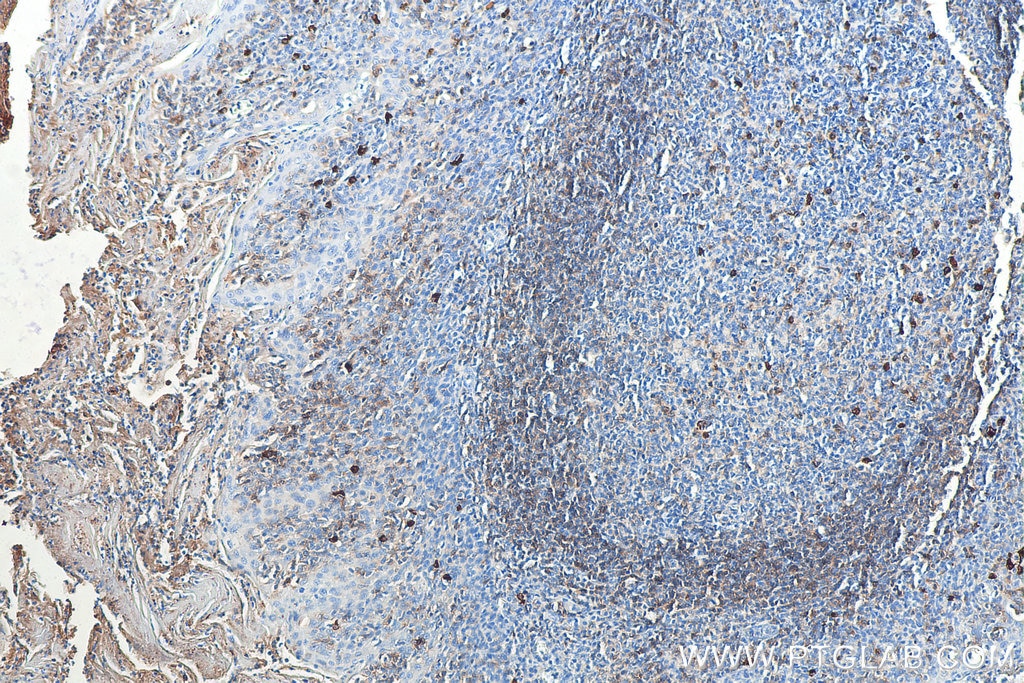human IgD Monoklonaler Antikörper
human IgD Monoklonal Antikörper für IHC
Wirt / Isotyp
Maus / IgG2a
Getestete Reaktivität
human
Anwendung
IHC
Konjugation
Biotin
CloneNo.
1D1B12
Kat-Nr. : Biotin-67538
Synonyme
Galerie der Validierungsdaten
Geprüfte Anwendungen
| Erfolgreiche Detektion in IHC | humanes Tonsillitisgewebe Hinweis: Antigendemaskierung mit TE-Puffer pH 9,0 empfohlen. (*) Wahlweise kann die Antigendemaskierung auch mit Citratpuffer pH 6,0 erfolgen. |
Empfohlene Verdünnung
| Anwendung | Verdünnung |
|---|---|
| Immunhistochemie (IHC) | IHC : 1:50-1:500 |
| It is recommended that this reagent should be titrated in each testing system to obtain optimal results. | |
| Sample-dependent, check data in validation data gallery | |
Produktinformation
Biotin-67538 bindet in IHC human IgD und zeigt Reaktivität mit human
| Getestete Reaktivität | human |
| Wirt / Isotyp | Maus / IgG2a |
| Klonalität | Monoklonal |
| Typ | Antikörper |
| Immunogen | human IgD fusion protein Ag9614 |
| Vollständiger Name | immunoglobulin heavy constant delta |
| Berechnetes Molekulargewicht | 573 aa, 63 kDa |
| Beobachtetes Molekulargewicht | 55-70 kDa |
| GenBank-Zugangsnummer | BC021276 |
| Gene symbol | IGHD |
| Gene ID (NCBI) | 3495 |
| Konjugation | Biotin |
| Form | Liquid |
| Reinigungsmethode | Protein-A-Reinigung |
| Lagerungspuffer | BS mit 50% Glyzerin, 0,05% Proclin300, 0,5% BSA, pH 7,3. |
| Lagerungsbedingungen | Bei -20°C lagern. Vor Licht schützen. Aliquotieren ist bei -20oC Lagerung nicht notwendig. 20ul Größen enthalten 0,1% BSA. |
Hintergrundinformationen
IgD is the major antigen receptor isotype on the surface of most peripheral B-cells. The function of IgD is to signal the B cells to be activated. The relative molecular mass and half-life of secreted IgD is 185 kDa and 2.8 days, respectively. Secreted IgD is produced as a monomeric antibody with two heavy chains of the delta (δ) class, and two Ig light chains. This antibody detects the heavy chain (55-70 kDa) of IgD and secreted IgD (185 kDa) .
Protokolle
| Produktspezifische Protokolle | |
|---|---|
| IHC protocol for Biotin human IgD antibody Biotin-67538 | Protokoll herunterladen |
| Standard-Protokolle | |
|---|---|
| Klicken Sie hier, um unsere Standardprotokolle anzuzeigen |


